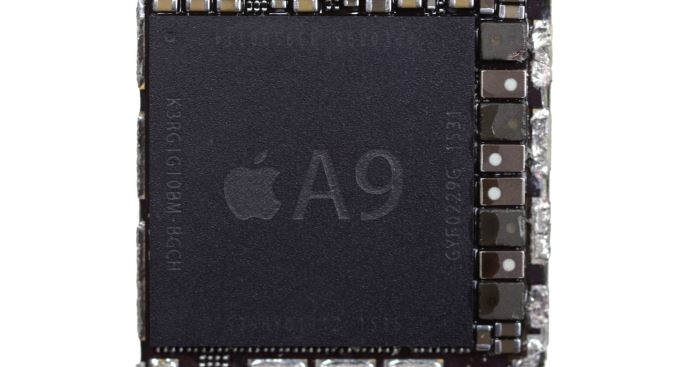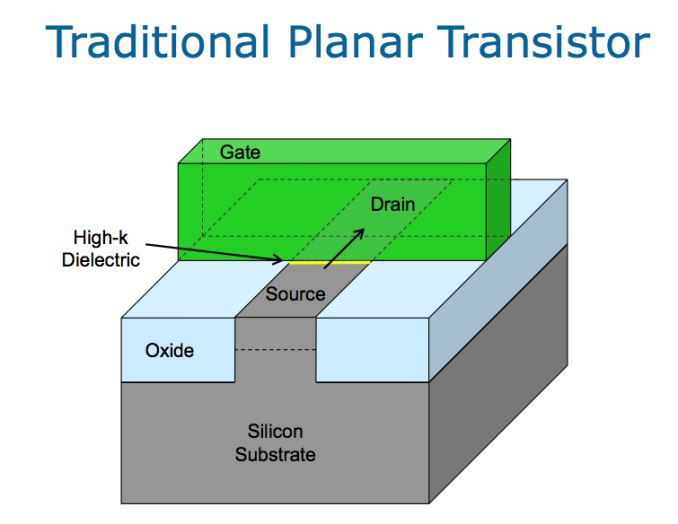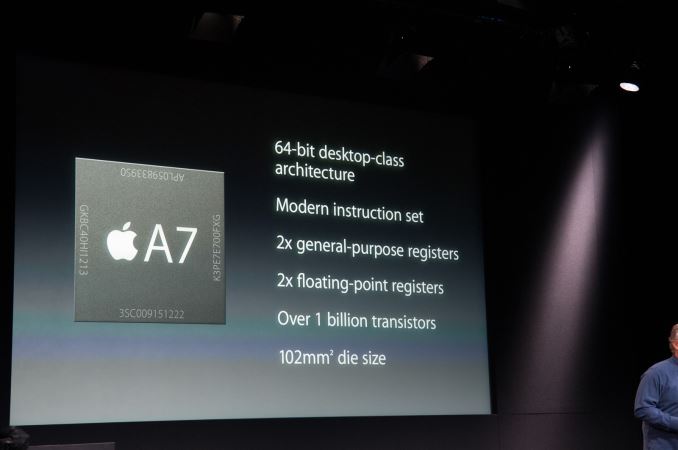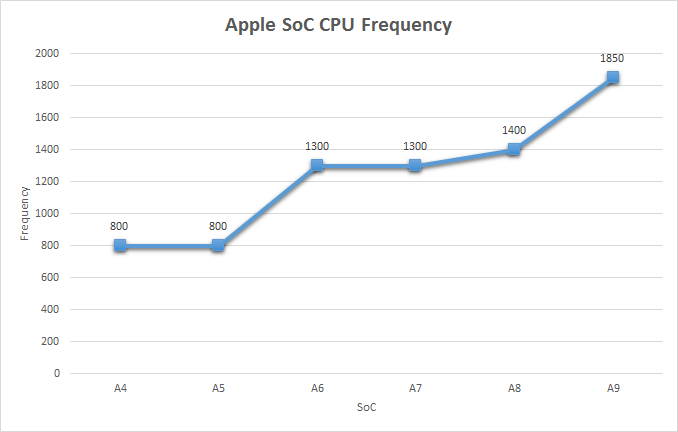The Apple iPhone 6s and iPhone 6s Plus Review
by Ryan Smith & Joshua Ho on November 2, 2015 8:00 AM EST- Posted in
- Smartphones
- Apple
- Mobile
- SoCs
- iPhone 6s
- iPhone 6s Plus
Analyzing Apple A9’s SoC
For Apple’s engineering teams, I’m still undecided whether Apple’s tick-tock style of SoC development is a curse or a blessing. That Apple more strongly invests in SoC development for the iPhone-S processors is a blessing, as it gives the engineering teams a bit of time to breathe and to plan out major architecture shifts over two years. On the other hand even for non-S iPhones the engineering teams still need to deliver an amazing product – iPhone 5 and iPhone 6 were no slouches – so I’m not sure how much of a breather the engineering teams actually get. They may have two years to space some of their transitions, but they must continue to deliver a top-tier SoC every year.
When Apple released the A7 SoC alongside the iPhone 5s in 2013, they pulled off something that rocked the SoC industry. The Cyclone CPU core all but came out of nowhere, beating previous estimates for the first ARMv8 64-bit phone SoCs (by any vendor) by roughly a year. As a result the 64-bit transition became a lot more important a lot sooner than anyone was expecting, and to this date some of Apple’s SoC competitors are still trying to recover from the shock of having to scramble to go 64-bit sooner than they planned.
As for Apple’s engineering teams, that we’re on another iPhone-S year means that there’s quite a bit of pressure to pull off a repeat performance, and I suspect that pressure is internal as much as it is external. A7 brought with it Cyclone, a CPU that was not only 64-bit, but thanks to its exceptional (for a mobile CPU) issue width of 6 micro-ops, brought with it a huge jump in single-threaded performance. At the same time A7 also saw Apple transition to PowerVR’s Rogue architecture GPUs (PowerVR G6xxx), which was a similar jump in GPU capabilities and performance, along with setting the stage for Apple’s proprietary, low-level Metal graphics API. A7 was everything Apple needed and more, cementing Apple’s place as a top-tier SoC designer and laying the groundwork for the performance advantage Apple has enjoyed over the past two years.

Apple's A9 SoC (Image Courtesy iFixit)
For 2015 then and for their latest iPhone-S, Apple has once again turned out a new SoC. This brings us to the A9, and in a year with an iPhone-S and almost no external design changes to speak of, all eyes are on what Apple has devised to go inside their phones.
| Apple A9 vs A8 SoCs | ||||
| Apple A9 (2015) | Apple A8 (2014) | |||
| Manufacturing Process | TSMC 16nm FinFET / Samsung 14nm FinFET |
TSMC 20nm HKMG | ||
| Die Size | 104.5mm2/96mm2 | 89mm2 | ||
| CPU | 2 x Apple Twister ARMv8 64-bit cores |
2 x Apple Typhoon ARMv8 64-bit cores |
||
| GPU | IMG PowerVR GT7600 | IMG PowerVR GX6450 | ||
Finally Fabbed with FinFETs
When the iPhone 6 launched I spent some time talking about how for the A8 SoC, Apple finally reached the point where they were building SoCs on a leading edge manufacturing process. That process at the time being TSMC’s 20nm planar process. The fact that Apple was building on a leading edge process was important for two reasons: 1) It was a strong indicator of how serious they were about SoC production and how much they were willing to spend in order to achieve the best possible performance, and 2) it meant that Apple had finally completely climbed the ladder (so to speak) and wouldn’t be able to “exceed the curve” just by catching up on manufacturing technology. Post-A8, Apple can only improve their performance by improving their architecture, building bigger chips, and finally, jumping to newer manufacturing processes as they become available.
What wasn’t said at the time – due to the fact that no one outside the fabs was quite sure – was where Apple would go in 2015. Had you asked me in 2014 what I would expect the A9 to be fabbed on, I would have suggested another round on TSMC’s 20nm process now that Apple had caught up to the leading edge. However much to my surprise (and to a steak dinner I lost a bet on) Samsung was able to get their 14nm FinFET process yielding well enough to supply Exynos 7420 in bulk for the Galaxy S6 launch nearly 6 months ago.
The fact that one of the contract fabs was able to get a FinFET process up and yielding well enough for volume production before the very end of 2015 has definitely changed the picture for what Apple can do. Once again they get to jump to a new manufacturing process for their next SoC, though this time by staying on the leading edge.


Planar vs. FinFET (3D) Transistors (via Intel)
While I’m not going to go into the physics of FinFET in depth here – we have some great articles on that already – I do want to quickly touch upon why this is so important. 14nm (and 16nm) FinFET isn’t just a new manufacturing node, but it’s part of a broader change in how transistors are manufactured. Simply put, FinFET (aka 3D transistors) are a long in development technology meant to help transistors scale to increasingly small scales, on the order of dozens of atoms or less.
FinFET transistors are necessary because as transistors get smaller their leakage (wasted power) goes up, and without FinFETs leakage would spiral out of control. In fact that’s exactly what happened on the 20nm nodes from Samsung and TSMC; both companies thought the leakage of planar transistors could be adequately controlled at 20nm, only for leakage to be a bigger problem than they expected. Due in large part to this reason, the 20nm SoCs released over the last 18 months have more often than not struggled with power consumption and heat, especially at higher clockspeeds. Apple is something of the exception here, with the 20nm A8 proving to be a solid SoC, thanks in part to their wide CPU design allowing them to achieve good performance without using high clockspeeds that would exacerbate the problem.
That said, while Apple managed to handle 20nm well enough, they were still ultimately at the mercy of a subpar process. The 14nm/16nm FinFET processes are what 20nm should have been all along, with the use of FinFETs drastically cutting down on leakage and reducing operating voltages – and now that FinFETs are here Apple no longer has to be as conservative as they were with A8. What that gives Apple then is a chance to push the envelope much harder on clockspeeds, taking their already wide CPU designs and turning up the clockspeeds as well.












531 Comments
View All Comments
nerd1 - Saturday, November 7, 2015 - link
720p screen in 2015, worse battery life, no sd slot, no wiress charging, terrible camera and still THE BEST phone huh?It has best performing processor, no one argues that, but I still wont touch it with a stick.
JaytB1 - Sunday, November 8, 2015 - link
I use iPhone mainly because of the better security/privacy, no carrier/manufacturer delay/total dismissal of security/OS updates, earlier/exclusive/better releases of triple A games/apps and uncluttered interface. I agree with the gold award, the iPhone 6s (plus) is the first phone in a while that made me see that there are still possibilities to innovate in the smartphone space.I've seen Android users avidly defending their high PPI's, megapixels, core counts. Oh, but it's customizable and I can put a ton of widgets on my homescreens. There's only a small minority of tech obsessed people who care (proof is in the huge low/medium end market share, indicating the amount who don't care for specs but just want a working phone). For me, all I want is to launch an app, not stare at my home screen. In the past, Android users where more often than not boasting about benchmarks and how their hardware was superior. Now that the tables are turned, hardware all of a sudden doesn't matter as much anymore or the tests must be rigged by a biased Anandtech (who has nothing to gain and everything to loose if they were posting nonsense).
I've seen Samsung and other manufactures add so many gimmicks to their phones, many of which are plain impractical (try doing 'airview' while jogging and you'll get the picture).
I admit that fast charging would be nice but, for me, completely unnecessary (it's not like an iPhone charges slow in the first place).
Then there's wireless charging, you do realize that you still have to plug in the charge pad with a cable right? So the only difference is that you don't need to plug that cable into your phone, but you'll need more power to fill your device up as compared to using a cable (more waste power) and a permanent spot for your charging pad. Again, for me I don't really see the appeal for that either.
We could also talk about PPI but to keep it brief, I'd rather have a device perform well with individual pixels I can't distinguish, than a screen that would impact performance with pixels I still can't see... But more of them.
I could go on about how a blind photo evaluation test on a respected Android site had Android users voting the iPhone 6s as having the best overall picture quality, but now that the iPhone scored a tiny bit lower than some Android phones in one test, it suddenly has a 'far inferior' camera. Then there's the RAM, curved screens and so many other things I could mention, but my point is that I think Android users can't recognize a genuine game-changing feature-list because they're so used to getting bombarded by tons of arguably useless high spec lists and gimmicks that are marketed as 'the next big thing'.
It's almost as if Google took over the reality distortion field from Apple. Just wait a couple of years when all Android devices have 'Android sense' (or something) displays (3D touch), THEN it will be a game changing feature because they'll have 1000's of pressure levels they can sense as compared to the 'useless' iPhone's (hypothetical) 128 levels.
Don't get me wrong here, I'm not trying to bash Android or people who choose to use it, I just don't like those who post nonsense without anything to back it up just so they can sleep at night having convinced themselves that they bought the right phone. I've been a reader of this site for years and believe their test results to be correct, as they've always been. People who claim otherwise should come with facts or stop sprouting nonsense.
I, for one, agree with the review and think it's the phone with the best all round feature set on the market today. Is it perfect? Of course not, but it's a genuinely forward thinking and exceptional smartphone in a stale smartphone market, and that deserves that gold award in my book.
Thanks for the review!
Aritra Ghatak - Sunday, November 8, 2015 - link
As the reviewers pointed various aberration and distortions associated with using a brighter lens and that it is wise Apple went with the F 1/2.2 aperture lens. Could you please explain how Samsung manages with an F 1/1.9 aperture lens in Galaxy S6? Or for that matter the F 1/1.8 lens in LG G4 or Nokia Lumia 720/730?patamat - Sunday, November 8, 2015 - link
Well, we all know who Anand went to work for after writing few "balanced" reviews like this one.(apple ...)
Psymac - Monday, November 9, 2015 - link
Where is the phone function analysis of this iPhone?zimmybz - Tuesday, November 10, 2015 - link
I guess I'll try to build the bridge for the Droid guys here that are having a hard time.I haven't had an iPhone since the Galaxy S came out. Been a droid user since.
I recently got a 6S Plus. I sold a Note 5 and cancelled a pre-order for a Nexus 6P.
I will say it since nobody else will. The Note 5 has a great camera, S-Pen is cool, and enough RAM to keep multi-tasking running, but otherwise it's a shitty phone. The battery life and Touchwiz still leave a LOT to be desired. Build quality is great, but it suffers from what every other Droid phone suffers from - fractured, fragmented hardware eco-system and specs driven production. (Hang on)
If you need to know why you should cancel a 6P pre-order, look at the subreddit (Holy crap, lol.)
Anyways, in my first week with the 6S Plus, I hit 22% battery with 88 hours standy and 13 hours usage. That is completely insane.
Back to the Note 5 - look at the graphs on the review here. This phone absolutely DOMINATES the Note 5 across the board, a fact which I can confirm first hand.
I can also tell you that holding the phones side by side looking at the same picture taken on the Note 5, the displays are functionally indistinguishable from the other. (So much for all that resolution, I guess)
This is a large reason why the Note stutters against the 6S Plus. It's pushing a LOT of pixels that aren't really evident in day to day use, especially sitting next to the iPhone.
I guess I finally reached the point, I just want the best phone every year regardless of manufacturer or software.
Until Google makes it's own hardware in house and breaks free of QualComm, Apple is going to beat them every year going forward. I'm not 20 anymore, I don't care about a home screen widget. I want the battery not to drain from some stupid Google Play Services memory drain while the phone is sitting on my desk.
I don't want Samsung Services blowing up the battery either. And - NO - I should not have to root kit, Package Disable, Power Saver, Turn off Location, etc, etc, etc. I paid $1000 for a premium handset with lots of features.
Oddly enough, the iPhone can leave all that crap on and STILL get good battery life. The arguments for Android are shrinking right now. I'll never buy another Samsung phone again. I will miss the S-Pen, but Touchwiz is heinous, even in it's current iteration.
I would really love to see Google put up a fight in the premium handset market, but I don't think their hearts are in the hardware QUITE yet.
Anyways, happy 6S Plus user here, 4+ year droid convert at the moment. We'll see what next year brings.
zeeBomb - Wednesday, November 11, 2015 - link
Ss or bs (sorry I just had to)JTRCK - Friday, November 13, 2015 - link
I actually returned a 6S Plus for the Nexus 6P and the main reason was PRICE. They are as equally performant in day to day tasks, but the Nexus 6P had better multitasking performance for me due to the buttons and added power of a side launcher which is not possible on iPhone. I basically never have to go to the home screen again when using Google docs, searching the web, etc... I tried both out for about a week. The only feature I liked on the iPhone 6S Plus better was the cooler white colors of the LCD; other than that the Nexus 6P was better "for me" in every aspect. The phone "flies" in every sense of the word. No stutters, no lag, no unresponsiveness (typical of Samsungs). I have been an iPhone user since the 3GS. I also used the iPhone 6 Plus this year for 5 months.And I truthfully don't understand all this commotion over the new iPhone 6S Plus being the best phone ever released. Outside of "3D touch," there is not much difference in day to day performance or general use between both this year's model and last year's model. That is generally a great testament to iOS stability and performance. So much so that my old iPhone 4s opened apps faster, surfed faster, multitasked faster, etc, than my now defunct Note 4. Apple has been on top of their game for years, IDK why android fans have only now noticed. But iOS is truly very limited. You will sooner or later find out the gates keep you truly locked in.
But the main factor for me, again, was price. I do not in any way find the iPhone to be a better phone than the Nexus 6P. In fact, I find its system to be inferior in a multitude of ways. Is the iPhone Better than the Note 5 and all its clumsy and useless features? Yes. But the Nexus 6P is in a category all its own. Especially for $650. That is exactly what I paid for the 128GB model compared to the $1,170 I paid for the iPhone 6S Plus.
astroboy888 - Wednesday, November 11, 2015 - link
"FinFET transistors are necessary because as transistors get smaller their leakage (wasted power) goes up, and without FinFETs leakage would spiral out of control. In fact that’s exactly what happened on the 20nm nodes from Samsung and TSMC; both companies thought the leakage of planar transistors could be adequately controlled at 20nm, only for leakage to be a bigger problem than they expected"It is not they "discovered" 20nm leakage was high; therefore they switched to 16nm FinFet. This is an incorrect comment.
FinFet transistors structure had been on the road map and in development at TSMC for more than 10 years. TSMC's first finfet transistor was demonstrated in 2002 when the inventor Professor Chen-Ming Hu of UC Berkeley was working at TSMC as CTO. Therefore Finfet process had always been on the roadmap for 16nm process. The 20nm planar process had always been on the road map as a planar process. Every process node takes about 3-5 years to develop, so the customers (semiconductor chip designers) signs up 3-5 years before hand to co-work with TSMC to design a chip for that process. These were communicated ahead of time and contracts where signed.
In the late 1990s and early 2000s, the semiconductor industry was pushing for SOI (Silicon On Insulator such as GaAs "Gallium Arsenide), which completely eliminates leakage current. But the transistor performance turned out to be too unpredictable and too expensive to manufacture. Therefor the industry stuck with silicon, until FinFet structure was invented in 2000 and manufacturing process perfected some 10 years later.
gonsolo - Thursday, November 12, 2015 - link
If I may suggest something: I'd like to see app startup times as a benchmark from iPhone 5 onwards. This is something I'm doing a lot; waiting for apps to start.